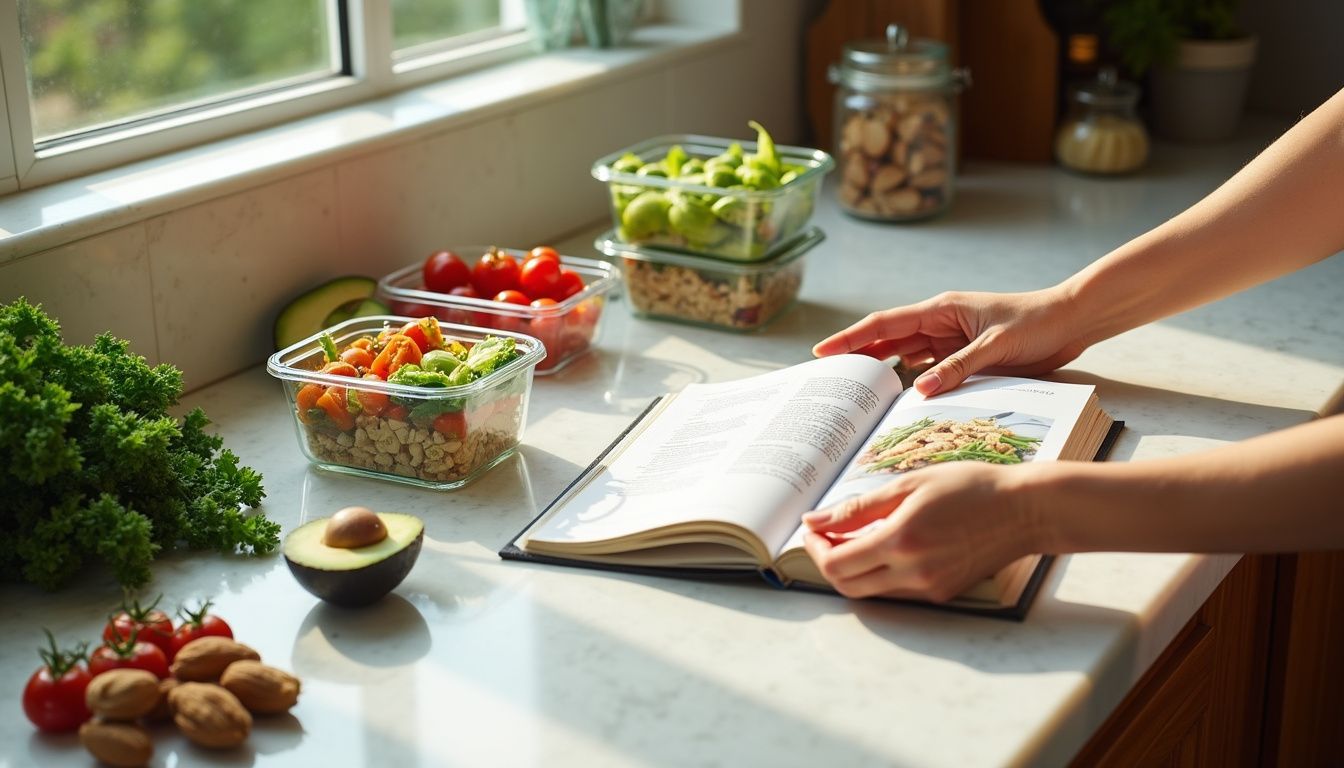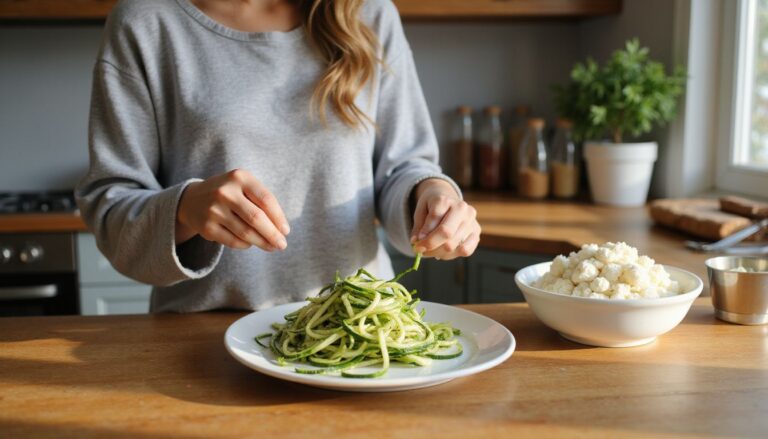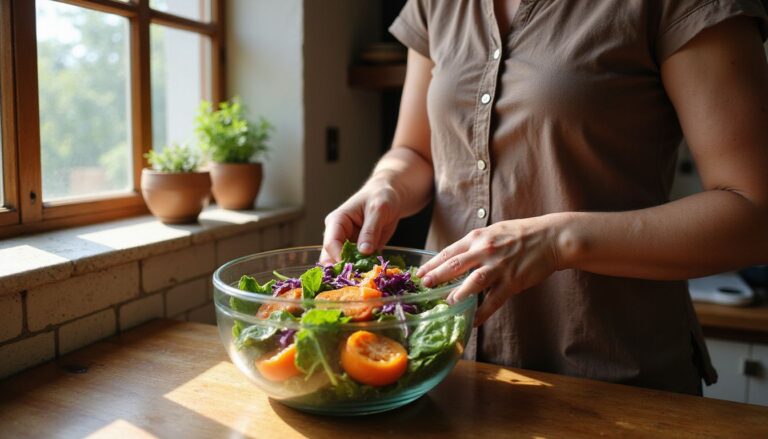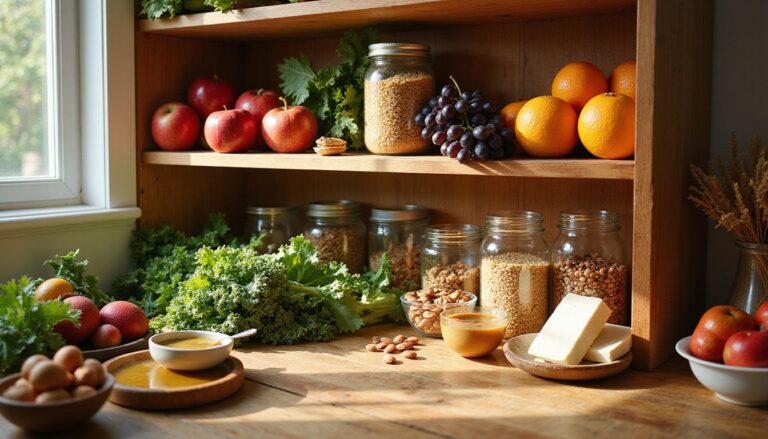Ultimate Low Carb Diet Meal Plan: Delicious Recipes For A Healthier You
Our Nutrition Assistant AI Suite will transform your body. You will lose fat, get toned, and build muscle. Gain confidence and optimal health.
Keeping weight steady, or managing blood sugar, can feel hard when high-carb foods show up at every meal. I have faced the same struggle, and a low-carb meal plan helped me regain control.
Research suggests that eating fewer than 130 grams of carbohydrate per day can support weight management and better blood sugar control. In this guide, I explain the basics, share quick meal prep tips, and offer simple recipes for breakfast, lunch, dinner, and snacks. Start with one small change today, then build from there.
Key Takeaways
- A low-carb diet limits carbohydrate to under 130 grams per day. This approach can aid weight, energy, and blood sugar management.
- People in a 2021 study reported fewer cravings and better appetite control on a lower-carb pattern than on higher-carb diets.
- Core foods include lean meats, fish, eggs, non-starchy vegetables like spinach and broccoli, healthy fats such as olive oil or avocado, and plain Greek yogurt.
- For best results, limit candy, soda, chips, potatoes, white bread, rice, sweetened drinks, and very sweet fruits like ripe bananas.
- Swapping grains for cauliflower rice or zucchini noodles can reduce total carbs, support heart health, and lower inflammation in some people.
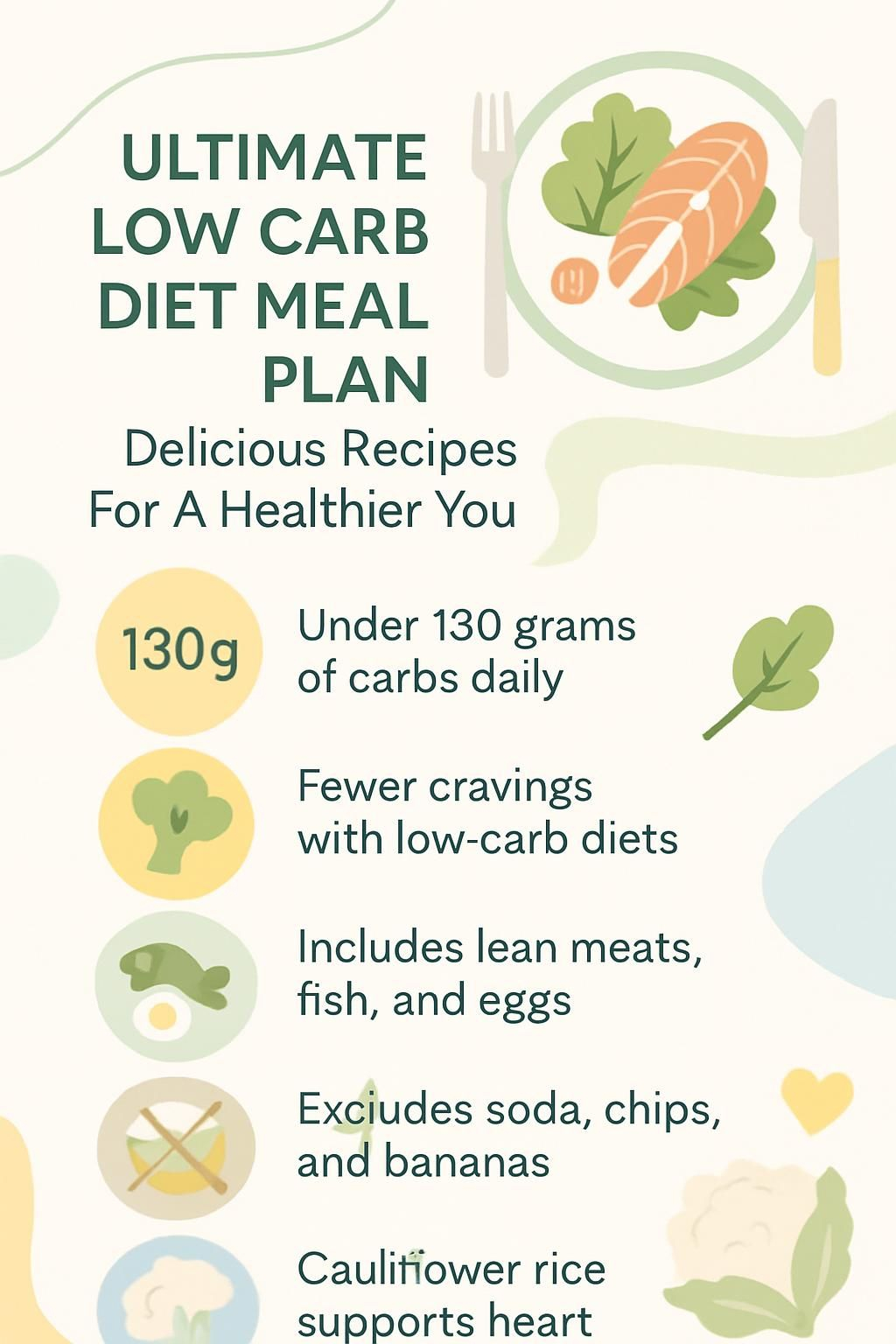
Understanding Low Carb Diets
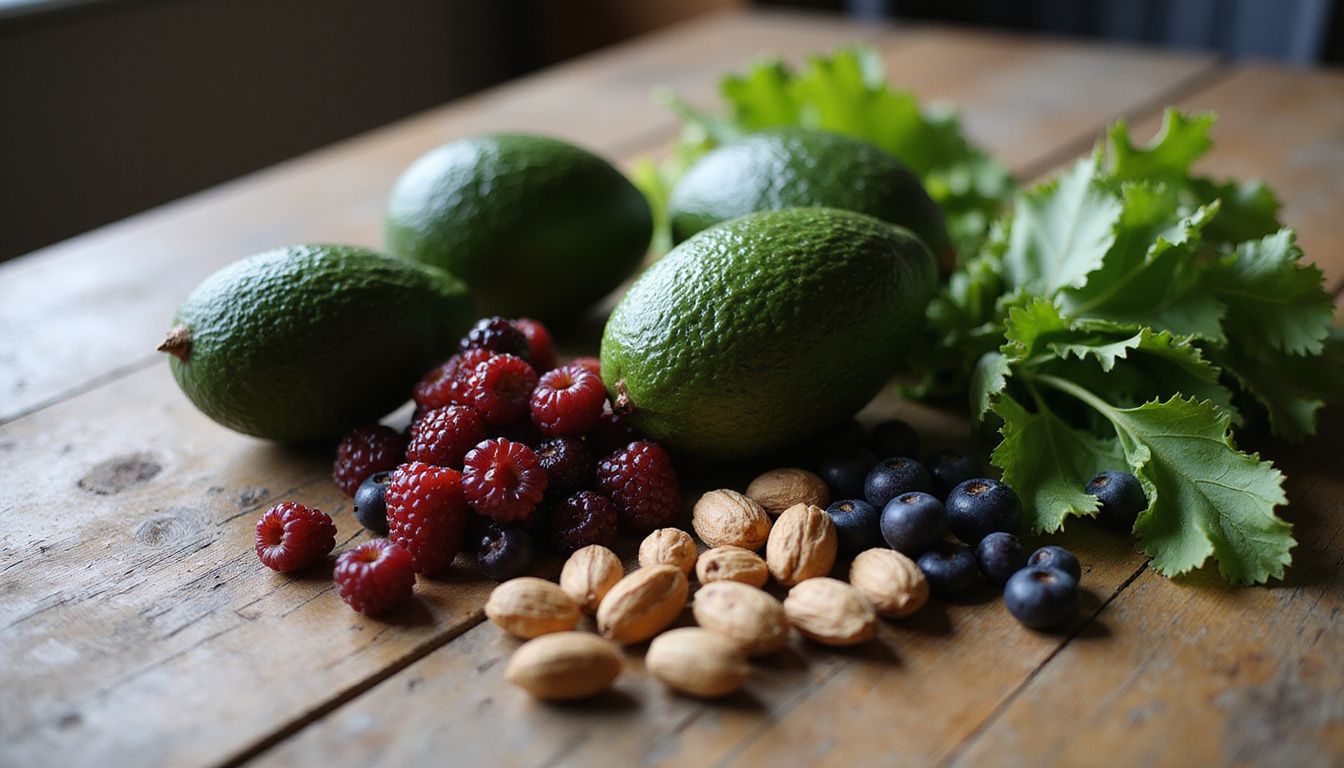
A low-carb diet limits carbohydrate foods to help manage blood sugar and weight. Many people feel more energetic after reducing sugars and starches because their blood glucose stays steadier through the day.
What are the basics and benefits of low carb eating?
Low carb eating means cutting back on high-carb foods like bread, pasta, sugary drinks, and starchy vegetables. Many plans aim for under 130 grams of carbs per day on a 2,000-calorie diet.
I build plates around protein, non-starchy vegetables, and healthy fats. Examples include eggs, chicken, or Greek yogurt with vegetables such as cauliflower or cucumber, plus olive oil or avocado for flavor and fullness.
Research shows that lower-carb approaches can help you lose weight faster than lower-fat plans in the short term, and they can improve blood sugar for people with type 2 diabetes or prediabetes. Cutting added sugar and processed foods may also reduce risk factors linked to heart disease.
How does reducing carbohydrate intake improve health?
Learning the basics sets the stage for how fewer carbs may help health markers. Lowering carbohydrate can steady blood sugar, which matters for diabetes care and prevention.
When I eat fewer carbs, my body may tap stored fat for energy, which supports weight loss. The American Diabetes Association notes that lower-carb patterns can help some people with type 2 diabetes or prediabetes.
A 2021 study found that many people on lower-carb plans felt less hungry and had fewer cravings. Higher protein and healthy fats can increase fullness, so you naturally eat fewer calories without feeling deprived.
Keeping foods high in sugar and starch off the plate supports healthier blood pressure, cholesterol, and triglyceride levels for many people over time.
“Reducing carbs may lead to lower appetite and better control over food choices.”
If you take diabetes medication, tracking carbohydrates is important because it influences HbA1c, a long-term blood sugar marker. I keep vegetables and fresh fruit in my plan for fiber, then choose portions that fit my daily goals.
Core Principles of Low Carb Eating
I use a low-carb meal plan to manage body weight and daily energy. Focusing on a few simple rules makes the approach easier to follow and sustain.
How can I cut down on sugars and starches effectively?
Cutting sugars and starches gets easier with small, steady changes. These steps helped me lower carbs without feeling restricted.
- Pick whole grain choices over white rice, white pasta, or tortillas to reduce carb load and increase fiber.
- Skip sweets like candy, ice cream, cookies, and pastries that add fast sugar and little nutrition.
- Replace soda, sweet tea, and sports drinks with water, sparkling water, or unsweetened coffee or tea.
- Ask for sauces and dressings on the side to control hidden sugars.
- Build meals around protein sources like eggs, strained yogurt, poultry, fish, or plant proteins.
- Read nutrition facts to spot added sugars that do not fit your goals.
- Limit highly processed foods like chips and fast food that contain refined grains and hidden sugars.
- Split large restaurant portions and bring half home to keep carbs and calories in check.
Once sugars and starches are lower, the next focus is protein and healthy fats for steady energy and better satiety.
Why focus on proteins and healthy fats in a low carb diet?
After reducing carbs, I need foods that fill me up and keep me energized. Protein and healthy fats do that job well.
Protein helps maintain muscle during weight loss and reduces hunger. Healthy fats from olive oil, avocado, nuts, and seafood provide steady energy and help absorb fat-soluble vitamins A, D, E, and K.
Studies show protein at each meal improves fullness compared to carbs alone. A breakfast with eggs keeps me full longer than cereal or toast. Butter or a splash of heavy cream can add flavor without causing a blood sugar spike.
These choices also support hormones and long-term health for people who follow low-carb styles like keto or the South Beach Diet.
What low-carb vegetables should I include in my meals?
Non-starchy vegetables are the backbone of a healthy low-carb plate. They deliver fiber, vitamins, and minerals with fewer carbohydrates.
- Spinach has about 3 grams of carbs per cooked cup and supplies iron and vitamin K.
- Broccoli contains about 6 grams per cup and provides vitamin C and fiber.
- Cauliflower offers roughly 5 grams per cup and works as rice or mash.
- Carrots add crunch, about 10 grams per cup, plus beta-carotene.
- Asparagus brings flavor at about 4 grams per cup and is rich in folate.
- Tomatoes offer about 7 grams per cup, plus potassium and vitamin C.
- Zucchini has about 4 grams per cooked cup and can be turned into zoodles.
- Brussels sprouts provide fiber at about 8 grams per cooked cup.
- Green beans deliver about 7 grams per cup and pair with many proteins.
- Rutabaga offers unique flavor at about 12 grams net carbs per cup.
Each of these helps me stay full because of the fiber. I pick portions that fit my daily carb target, whether under 50 grams or under 100 grams.
Essential Foods for a Low Carb Diet
The right foods make low-carb eating simpler and more enjoyable. I choose options that are high in protein and healthy fats, then add colorful vegetables for balance.
Which protein sources are best for a low carb diet?
Protein choices shape my meals and help control appetite. I look for nutrient-dense options with minimal carbs.
- Lean meats like beef, pork, and chicken are rich in protein with very few carbs.
- Fish such as salmon, trout, cod, and tuna offer omega-3 fats and nearly zero carbs.
- Eggs provide about 6 grams of protein per egg with minimal carbohydrate.
- Plain Greek yogurt is creamy, high in protein, and low in sugar when unsweetened.
- Shrimp delivers lean protein for salads, bowls, or stir-fries.
- Grilled chicken or a small ribeye can be satisfying main dishes.
- Ground turkey works well for sauces, bowls, and stuffed vegetables.
- Hard-boiled eggs or a few slices of bacon can be simple, filling snacks.
After protein, I plan vegetables that keep carbs modest and nutrition high.
What vegetables are low in carbs and nutritious?
Vegetables round out my plate with fiber and micronutrients. The right mix keeps blood sugar steady and supports weight goals.
- Spinach is very low in carbs and high in iron and magnesium.
- Broccoli supplies vitamin C and fiber at about 4 grams net carbs per cup chopped.
- Cauliflower can be mashed or riced with about 2 grams net carbs per cup.
- Zucchini makes great noodles, about 3 grams net carbs in a medium piece.
- Green beans bring fiber and potassium at about 4 grams net carbs per cooked cup.
- Brussels sprouts are filling at under 5 grams net carbs per half-cup cooked.
- Cherry tomatoes brighten plates with about 3 grams net carbs per half cup.
- Baby carrots offer crunch at about 6 grams net carbs per serving.
- Asparagus is rich in folate and under 2 grams net carbs per half cup cooked.
- Rutabaga can stand in for mashed potatoes with fewer carbs per cup.
I use these vegetables every week. Mixing leftovers with a protein makes quick lunches that still fit my plan.
What are good sources of healthy fats to eat?
Healthy fats improve flavor, fullness, and nutrient absorption without raising carbs. I keep these on hand for cooking and simple meals.
- Avocados and avocado oil provide monounsaturated fat with very low carbs.
- Olive oil adds antioxidants and has zero carbohydrate.
- Coconut oil contains medium-chain triglycerides, which the body can use for quick energy.
- Cheese, butter, and heavy cream add richness and calcium with minimal carbs.
- Nuts and seeds, like almonds, walnuts, peanuts, chia, and sunflower, deliver healthy fats and protein.
- Full-fat Greek yogurt offers a balance of protein and fat with a modest carb count.
- Rendered animal fats can be used for roasting or searing without added sugars.
- Dark chocolate at 70 percent cocoa or higher satisfies a sweet tooth with fewer carbs than milk chocolate.
Using these fats helps me feel satisfied, which makes it easier to stay consistent.
What low carb snacks can I enjoy without guilt?
Smart snacks bridge the gap between meals without a blood sugar spike. I pick options with protein, fiber, or healthy fats.
- Plain Greek yogurt with a few blueberries adds protein and minerals.
- Hard-boiled eggs are portable and under 1 gram of carbs each.
- Baby carrots offer crunch and fiber with modest carbs.
- A small handful of nuts supplies healthy fats and steady energy.
- Cheese slices with deli turkey add protein and almost no sugar.
- Leftover grilled chicken or turkey breast works as a fast snack.
- One small square of dark chocolate provides antioxidants with limited carbs.
- Nut butter on celery or cucumber is filling and low in starch.
- Plain sunflower seeds add minerals and keep hunger in check.
These choices fit low-carb principles and help control cravings between meals.
Foods to Exclude from a Low Carb Diet
Some foods are heavy in sugars and starches. Keeping them off my plate helps me reach weight and blood sugar goals faster.
Which sugary foods and drinks should I avoid?
Sugary foods and drinks push blood sugar up fast, then energy drops soon after. I steer clear of these to stay on track.
- Candy of all types is concentrated sugar and easy to overeat.
- Ice cream often includes a high sugar load, even in small portions.
- Cakes, cookies, muffins, and pastries combine sugar with refined flour.
- Soda, sports drinks, fruit punch, and sweet tea add many empty calories.
- Sweetened cereals spike blood sugar and leave me hungry later.
- Sugary cocktails and flavored liquors can blow through daily carb limits.
- Sweet sauces like ketchup, BBQ sauce, and honey mustard hide added sugars.
- “Diet” and “low-fat” items can include extra sweeteners to boost taste.
- Frozen desserts, even light versions, often rely on syrups and added sugar.
Why should I skip highly processed foods?
Fast food, chips, cookies, and frozen entrees often pack refined starch and added sugars. These products may also contain additives that drive cravings.
I once bought “low-fat” snacks that seemed healthy. Later I found they had more sugar than fresh fruit. Processed meats can include starchy fillers that slow progress on a low-carb plan.
High processing removes fiber and often adds salt and preservatives, which can increase water retention in some people. Choosing fresh foods supports better blood sugar control and steadier energy.
What starchy vegetables and high-carb fruits should I limit?
Starchy vegetables and some fruits quickly increase carbs per meal. Tracking portions keeps my plan consistent.
- White potatoes have about 37 grams of carbs per cup. I skip fries and mash most days.
- Sweet potatoes contain about 27 grams in a medium piece. I keep portions small.
- Corn has about 30 grams per cup, so I choose lower-carb sides instead.
- Peas provide about 21 grams per cup, which can add up fast.
- Yams have around 27 grams of carbs in one medium piece.
- Bananas contain roughly 27 grams in a medium fruit.
- Pineapple has about 22 grams per cup of chunks.
- Mango has about 25 grams per cup and is very sweet.
- Lentils, black beans, chickpeas, and pinto beans can top 40 grams per cooked cup, so I use small portions.
- Whole grains like brown rice, oats, and quinoa deliver 20 to 30 grams net carbs per half cup cooked.
Knowing these numbers helps me pick what I love, then plan the rest of the day around it.
How does reducing grains benefit a low carb diet?
Meals with white rice, crackers, and white pasta can push daily carbs over target. Lowering grain intake helps me keep blood sugar stable and cravings lower.
Many low-carb plans, including Atkins and keto, limit grains for this reason. I use cauliflower rice or zucchini noodles for texture, plus extra vegetables for nutrients and volume. Some people notice less bloating and better digestion with fewer refined grain products.
Weekly Low Carb Meal Plan
This weekly plan focuses on simple recipes and balanced nutrition. I keep meals repeatable, tasty, and easy to prep.
What are some healthy low carb breakfast ideas?
A strong breakfast sets the tone for the day. These ideas fit most lower-carb goals while keeping me full.
- Hard-boiled eggs with avocado slices, about 3 grams net carbs, and very satisfying.
- Low-carb blueberry muffins made ahead for quick mornings.
- Two slices of sprouted Ezekiel bread with half an avocado, about 36.5 grams of carbs, as a higher-carb option that still brings fiber.
- Plain Greek yogurt with blueberries and almonds, about 19.4 grams of carbs, plus protein for steady energy.
- Scrambled eggs in butter, topped with a little cheddar cheese.
- Omelet muffins with egg whites, mushrooms, spinach, and cheese, made in a batch and frozen.
- Low-carb bread with about 3 grams net carbs per slice for toast or sandwiches.
I favor real, fresh ingredients. They offer more nutrition and help curb morning cravings.
Which lunch options fit a low carb plan?
Lunch should be balanced with protein, healthy fats, and vegetables. That combo keeps energy steady until dinner.
- Grilled chicken breast, about 3 ounces, with two cups of zucchini noodles, around 17 grams of carbs total.
- Small ribeye, about 3 ounces, with mashed rutabaga and sautéed green beans, around 13.5 grams total.
- Shrimp garden salad with 2.5 cups mixed greens and vinaigrette, about 10.5 grams of carbs.
- Vegan burrito bowls made with cauliflower rice for fewer carbs and lots of flavor.
- Zucchini noodles topped with turkey Bolognese for extra protein.
- Spicy slaw bowls with shrimp and edamame for crunch and variety.
- Chicken satay bowls with a simple peanut sauce and fresh vegetables.
- Most low-carb lunches focus on lean protein, high-fiber vegetables, and healthy fats to stay full.
What dinner meals are low in carbohydrates but satisfying?
Dinner is where I lean into bold flavors and filling portions without the extra starch.
- Bunless burger with cheddar and steamed broccoli, about 8.5 grams of carbs.
- Lettuce wrap burgers with dill pickle and tomato for crunch without the bun.
- Roasted chicken with a side of cauliflower rice for fiber and fewer carbs.
- Cauliflower rice stir-fried with eggs, peppers, and coconut aminos for a takeout feel at home.
- Egg salad lettuce wraps for a light, no-cook option.
- Grilled chicken, half cup Brussels sprouts, and half cup quinoa, about 25.2 grams of carbs, for those who need a bit more.
- Mexican-style skillet meals with lean beef, peppers, onions, and cheese for rich flavor with fewer carbs.
Each dinner helps me manage carbs without feeling hungry later.
What are some easy and tasty low carb snack ideas?
Quick snacks make it easier to stick to a routine. I keep simple choices ready so I do not reach for sweets.
- Fresh berries like strawberries or blueberries for gentle sweetness.
- Plain Greek yogurt for protein that lasts.
- Hard-boiled eggs for a portable option with almost no carbs.
- A handful of almonds or walnuts for healthy fats and fiber.
- Cheese with turkey or chicken slices for a filling bite.
- Baby carrots for crunch with modest carbs.
- Leftovers from lunch or dinner to prevent waste and save time.
- Two small squares of dark chocolate at 70 percent cocoa or higher.
Trying new recipes next can add more variety without complicating meal prep.
Recipe Inspirations for Low Carb Meals
I keep recipes simple and repeat the ones I love. Small tweaks to ingredients can transform an everyday meal.
What are simple low carb breakfast recipes?
These breakfast recipes are quick to prepare and easy to scale for the week.
- Scramble egg whites, mushrooms, spinach, and cheese for a meal under 10 grams of carbs.
- Bake low-carb blueberry muffins in batches for grab-and-go mornings, under 8 grams net carbs each.
- Fry eggs in butter, then top with a little cheddar, about 2 grams net carbs.
- Make loaded baked omelet muffins with eggs, veggies, and meat, then freeze.
- Pair hard-boiled eggs with tomato and avocado for a nutrient-dense plate around 19 grams of carbs.
- Toast low-carb bread, about 3 grams net carbs per slice, and add eggs for a balanced sandwich.
- Use sprouted Ezekiel bread with avocado for healthy fats and fiber, about 36.5 grams of carbs total.
Each option supports daily carb goals and keeps energy steady through the morning.
How can I make delicious low carb lunch meals?
Tasty lunches do not need complex steps. I rely on simple methods and smart swaps.
- Grill about 3 ounces of chicken and serve with 2 cups of zucchini noodles for about 17 grams of carbs.
- Prep cauliflower rice burrito bowls for the week to save time and cut carbs.
- Build bowls with protein, non-starchy vegetables, and healthy fats, then finish with an olive oil vinaigrette.
- Swap grains for spiralized or riced vegetables like zucchini or cauliflower to reduce carbs.
- Try a shrimp garden salad with vinaigrette, about 10.5 grams of carbs per serving.
- Rotate dishes like turkey Bolognese on zucchini noodles or spicy slaw bowls with shrimp and edamame.
- Make chicken satay bowls for a flavorful lunch rich in protein and healthy fats.
What are creative low carb dinner recipes to try?
Dinner is a chance to explore new flavors while staying within carb limits. These recipes are easy to repeat.
- Bunless burgers with sharp cheddar and steamed broccoli, about 8.5 grams of carbs.
- Roasted chicken with Brussels sprouts and a scoop of quinoa, around 25.2 grams of carbs.
- Lettuce wrap burgers with tomato and a dill pickle for a fresh twist.
- Cauliflower rice stir-fried with coconut aminos, eggs, and diced peppers.
- Mexican-style skillet with lean beef, peppers, onions, and a sprinkle of cheese.
- Chicken satay bowls prepped ahead for quick dinners on busy nights.
- Egg salad lettuce wraps, especially handy during hot weather.
What low carb dessert options satisfy sweet cravings?
Sweet treats can fit a low-carb plan with the right ingredients and portions.
- Dark chocolate at 70 percent cocoa or more, enjoyed in small amounts.
- Plain Greek yogurt with raspberries or blueberries for a creamy dessert.
- Low-carb blueberry muffins with almond flour and stevia, snack or dessert.
- Dry wines without added sugar, such as cabernet sauvignon or pinot grigio.
- Berry parfaits layered with Greek yogurt and chopped almonds for crunch.
- Cheesecake bites sweetened with erythritol for a quick treat.
- Small servings of berries like strawberries or blackberries to curb cravings.
Advantages of a Low Carb Diet Plan
A low-carb approach can improve health in several ways. I noticed better energy and fewer cravings after I shifted my meals.
How does a low carb diet support weight loss?
Lower carbohydrate intake can reduce insulin, a hormone that helps the body store fat. When insulin drops, the body can access stored fat more easily.
Very low-carb plans often lead to faster early weight loss than typical calorie-restricted diets. Many people start around 20 grams of carbs for a short phase, then add more based on goals.
Protein and healthy fats increase fullness, and fiber from vegetables helps control hunger. I had fewer snacks once I swapped cereal for eggs with spinach or avocado. A steady pace of one to two pounds per week is common when pairing lower carbs with moderate activity.
In what ways does it help stabilize blood sugar?
Limiting sugary foods, bread, pasta, and processed snacks helps prevent sudden blood glucose spikes. I use the Diabetes Plate method: half non-starchy vegetables, one quarter lean protein, and one quarter quality carbs.
I choose snacks with protein, healthy fats, and fiber to blunt blood sugar swings. Eating at regular times, about every two to three hours if needed, also supports steady insulin for people managing type 2 diabetes or prediabetes.
How can it boost energy and mental focus?
Steady blood sugar leads to steadier energy. Meals rich in protein and healthy fats, like eggs, salmon, avocado, and olive oil, keep me fueled longer.
Leafy greens and broccoli supply vitamins and minerals that my brain and body need. After I shifted my breakfast to eggs with greens, I had fewer afternoon slumps and less brain fog.
Some research suggests healthy fats can support brain function because the brain can use fat as fuel. That balance helps me stay focused during busy days.
Source: Gómez-Pinilla F, 2008, Brain foods: the effects of nutrients on brain function, Nat Rev Neurosci 9(7):568-578
Why does it reduce appetite and cravings?
Protein and healthy fats keep me fuller for longer, so I snack less between meals. High-fiber vegetables slow digestion and keep blood sugar steady, which helps cravings fade.
Planning snacks like nuts, seeds, or yogurt keeps me from reaching for sweets. Fewer blood sugar spikes also mean fewer sudden urges to eat.
Tips for Maintaining a Low Carb Lifestyle
Consistency comes from planning, smart shopping, and simple routines. A few habits make low-carb eating much easier to maintain.
How can meal planning and prep help maintain low carb eating?
Meal planning keeps me on track, even on busy days. Batch prep saves time and supports portion control.
- I follow a 30-day low-carb meal plan with different ideas, so I do not get bored.
- I prep breakfasts like egg muffins or chia puddings for fast mornings.
- Hard-boiled eggs, cheese, and turkey slices are ready-to-eat snacks.
- Each meal includes protein, healthy fats, and low-carb vegetables like spinach, broccoli, or zucchini.
- Batch burrito bowls or salad jars make weekday lunches grab-and-go.
- Meal prep helps me keep regular mealtimes, which supports steady blood sugar.
- Before dining out, I scan menus to choose lower-carb dishes or swap sides.
- I box half a restaurant meal to control portions and carbs.
- Planning ahead reduces late-night cravings and keeps choices simple.
What should I look for on labels to avoid hidden carbs?
Labels can hide sugars and starches. I check both the ingredient list and the nutrition facts panel.
- Spot sugars like sucrose, corn syrup, dextrose, and honey, even in “diet” items.
- Be careful with low-fat or diet labels, which often mean more sugar for taste.
- Watch sauces and dressings, and ask for them on the side when eating out.
- Avoid fillers like maltodextrin, modified starch, and potato flakes.
- Limit crackers, tortillas, and white pasta that raise carbs quickly.
- Choose foods with 5 to 10 percent carbohydrate if you follow stricter low-carb plans.
- Read the whole nutrition panel on convenience meals before buying.
- Check serving sizes since small packages may list tiny servings.
- Scan for both starches and artificial sweeteners that may affect your plan.
These steps help me dodge hidden carbs and stay consistent day to day.
How can trying new recipes improve my low carb diet?
Fresh recipes keep things interesting and prevent food boredom. Variety also helps cover more nutrients.
- Adding new flavors and textures makes meals more enjoyable and sustainable.
- Testing ingredients helps me find low-carb alternatives for bread or sweets.
- Planning new recipes ahead ensures quick, ready-to-eat options on busy days.
- Mixing different vegetables and proteins supports nutrition while controlling carbs.
- Finding favorites boosts motivation since meals feel less repetitive.
- Creative snack ideas can improve appetite control, as noted in a 2023 review from Harvard Health Publishing.
- Meal prep with new recipes saves time and helps me stay on plan.
Why is staying hydrated and balancing electrolytes important?
Hydration supports metabolism and steady energy. Electrolytes are minerals that help nerves and muscles work well, and low-carb eating can increase losses of these minerals early on.
- Water loss rises in the first week as glycogen, the stored form of carbohydrate, drops and releases water.
- Lower carbohydrate intake can increase sodium loss through the kidneys.
- I felt tired and headachy at first. Extra salt and magnesium relieved those early symptoms, often called “keto flu.”
- Drinking enough water aids digestion, brain function, and temperature control.
- Potassium, sodium, and magnesium are key. I get them from avocados, leafy greens, nuts, and broths.
- Activity raises fluid needs, so I drink more and watch for signs like cramps.
- Tracking water intake, about 8 cups daily for many adults, helps avoid dehydration symptoms, as noted in Journal of Nutrition, 2019.
- Good hydration also helps reduce unnecessary snacking.
Suitable Candidates for a Low Carb Diet
Many people feel better with fewer carbs. I saw positive changes and more control over my eating patterns.
Who benefits most from a low carb diet for weight loss?
People who manage diabetes often benefit because lower carbs help keep blood sugar steady. That stability supports consistent energy during the day.
Anyone seeking structure can also do well. Higher protein protects muscle while losing weight. Leafy greens and other high-fiber foods support digestion and help me feel full longer. Plant-based eaters can use tofu, tempeh, nuts, and seeds to follow a lower-carb pattern.
Is a low carb diet good for people with type 2 diabetes or prediabetes?
Lower-carb eating can help many people with type 2 diabetes or prediabetes. Building meals with meats or fish, eggs, non-starchy vegetables, and healthy fats keeps blood sugar more predictable.
The American Diabetes Association recognizes lower-carb patterns as one option for improving blood sugar and insulin sensitivity. I found that cutting sweets and processed foods reduced cravings and hunger. Tracking calories and macronutrients helped me reach goals and stay consistent.
How does it support better heart health?
Keeping blood sugar and weight in range supports heart health. I eat lean meats, fatty fish, eggs, avocados, olive oil, and plenty of non-starchy vegetables to keep carbs lower and nutrition high.
Clinical research shows that balanced lower-carb eating can improve cholesterol patterns for many people. Fewer processed foods and more whole foods also helped me reduce cravings and stick to my plan.
Avoidable Errors in a Low Carb Diet
Knowing the common pitfalls helped me stay consistent and avoid stalls in progress.
What hidden carbs should I watch out for?
Hidden carbs can creep into a day without me noticing. I learned to watch for these sources.
- Fruits like apples, oranges, and grapes have natural sugars that add up fast.
- Granola bars and flavored yogurts can include added sugars and starches.
- Vegan bowls made with rice, beans, or corn increase total carbs quickly.
- Tomato sauces and cheese blends in casseroles may include added starch.
- Nut mixes are easy to overeat, so I measure small portions.
- Mixed vegetables sometimes include peas or corn, which are higher in carbs.
- Sugar-free drinks and condiments may use sugar alcohols that affect some people.
- Large servings of cheese can add more carbs from lactose than expected.
- Store-bought dressings often use sweetened bases like honey vinaigrette.
- Low-fat packaged items often replace fat with sugar or maltodextrin.
- Even berries and bananas can push me over target if I skip measuring.
Why is getting enough fiber important on a low carb diet?
Fiber supports fullness and regular digestion. Since I limit grains and some fruits, I rely on non-starchy vegetables, nuts, seeds, and lower-sugar berries to meet fiber needs.
Too little fiber can lead to constipation and discomfort. A registered dietitian can help design a low-carb meal plan that still meets daily fiber goals without exceeding carb limits.
How can I avoid eating too much fat?
I choose whole foods and limit processed items to manage fat intake. Lean proteins like chicken breast, turkey, or fish keep calories in check.
Weekly meal prep helps me portion avocados, nuts, oils, and cheese. I also track calories, protein, carbs, fiber, fat, and sodium. If I need a snack, I pick protein or fiber, not more fat. This keeps my nutrition balanced.
How do portion sizes impact my low carb diet success?
Portion size affects carb totals and overall calories. Guessing portions can push me over daily targets without noticing.
I use the Diabetes Plate method to visualize balanced meals without weighing everything. Tracking macronutrients improves accuracy, and meal planning keeps portions consistent across the week.
Conclusion
Low-carb eating helped me feel more energetic and cut cravings. I enjoyed simple recipes built around vegetables, lean protein, and healthy fats, which supported better weight control and steady blood sugar.
Planning ahead made the routine easier, especially during busy weeks. If you have a medical condition, talk with your clinician or a registered dietitian to tailor the plan to your needs. With a few small steps, a low-carb meal plan can fit your life and still taste great.
FAQs
1. What is a low carbohydrate eating plan and how does it help with health?
A low carbohydrate eating plan limits foods high in starches and sugars, such as bread or pasta. This approach can support weight loss, improve blood sugar control, and may lower the risk of heart disease according to research from the American Diabetes Association.
2. Which foods are best for a healthy low carb meal plan?
Lean meats like chicken breast, fish such as salmon, eggs, leafy greens including spinach or kale, nuts like almonds, seeds such as chia seeds, and non-starchy vegetables form the foundation of most effective low carbohydrate diets.
3. Are there any risks linked to following a strict low carb diet?
Some people may experience fatigue or headaches when starting this type of meal plan; these symptoms often fade after several days. Studies published in The New England Journal of Medicine suggest that long-term use should be monitored by healthcare professionals to avoid nutrient deficiencies.
4. Can you share an example of a simple recipe from this meal plan?
One easy option is grilled turkey breast served with roasted broccoli and sliced avocado on the side. I have used this combination myself during busy weeks because it offers balanced nutrition while keeping carbohydrates very low.
Summary: A well-structured low carbohydrate diet focuses on lean proteins and non-starchy produce for better health outcomes supported by scientific evidence; careful food choices reduce risks while offering practical recipes for daily life.

